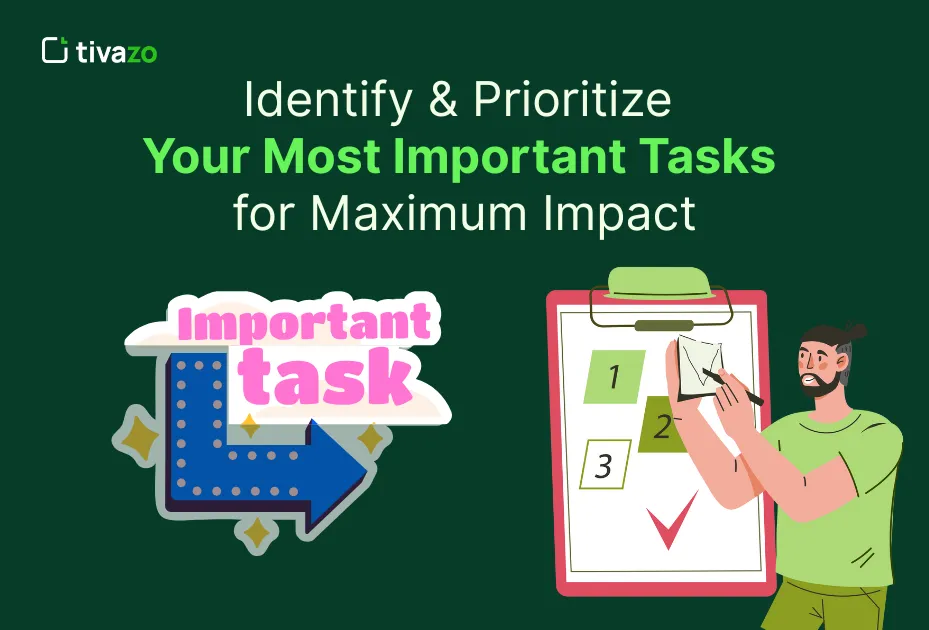Introduction: Why Managing Your Most Important Tasks Can Be a Total Game Changer
When your to-do list is long, it is easy to feel productive simply by checking items off the list. But we know they are not all equal. Knowing how to manage your most important tasks is one of the quickest ways to increase productivity while reducing your stress levels and making real progress towards your goals.
Instead of just reacting to the latest ping or low-priority task, successful professionals and teams manage their time and people around what matters most. When you consider the highest value actions, whether it’s closing a key deal, resolving a critical issue, or preparing your next product launch, these are the highest impact actions that make a huge difference for an organization.
This guide will help you identify, prioritize, and keep focused on your most important tasks each day while using proven techniques to minimize distractions, avoid toxic stress levels, and keep the energy and enthusiasm to do more with less.
Have you ever wanted to work smarter and not just harder? Everyone says working on the task at hand is the most important thing. Let’s work on freeing up your time to manage what is most valuable: time with your Most Important Tasks.
🔑 Key Takeaways: How to Identify Your Most Important Tasks
- Align tasks with your core goals for maximum impact
- Don’t confuse urgency with importance — focus on what truly moves the needle
- Use the Eisenhower Matrix and 80/20 Rule to prioritize strategically
- Block time daily for your MITs (Most Important Tasks)
- Review and reprioritize weekly to stay agile and focused
What Are The Most Important Tasks?
The most important tasks are the high-impact actions you need to take that directly correlate with your biggest goals and create positive results. These are not busywork, nor are they activities that we feel preoccupied by; they are the real tasks that generate progress in your business or career.
Treat these tasks like your daily Return on Investment (ROI) contributors: the tasks that, over time, deliver the greatest ROI.
Some examples of the most important tasks are
- ✅ Delivering a major client proposal
- ✅ Launching a marketing or sales initiative
- ✅ Repairing a critical bug that disrupts the user experience
- ✅ Following up with a high-value prospect or customer
They are not always glamorous or urgent, but they matter most.
Quick Tip: The most important tasks are rarely the most urgent.
Urgent things scream. Important things pay off.
When you learn to identify and rank your most important tasks, you will set yourself free from the busyness trap and get on the path to real forward momentum.
The Significance of Putting Your Most Important Tasks First
When you don’t complete your most important tasks, you become a prisoner of busyness, without getting anything done. You spend all your energy on what doesn’t matter, leaving you feeling demoralized, exhausted, and not living up to your potential.
When you fail to make your most important tasks a priority, you are:
- 🔄 Spending time doing low-impact or repetitive work
- 😫 Burning yourself out with speed and a reactive posture
- 🐢 Slowing your progress towards meaningful objectives
In comparison, people and teams that successfully complete their most important tasks on a consistent basis:
- 🚀 Do more with less stress
- 🎯 Make better strategic decisions daily
- 💪 Are developing momentum and confidence long-term
Acknowledge first: Want to accomplish your goals faster?
The answer is simple: take the first steps, every day, to identify your most important tasks and take action on them, first. important tasks first.
This is not only productive; it’s transformational.
5 Steps to Identify Your Most Important Tasks
Answer First: The fastest way to boost daily impact is to know and accomplish your most vital tasks—the handful of things that produce the biggest effects..

1. Identify Your Core Goals
You must have clarity on your core goals prior to identifying your most important tasks. Your core goals act as your guiding star and ensure your efforts are focused on what truly matters.
- Start by reviewing your weekly, monthly, or quarterly objectives. What outcomes are you aiming for?
- Ask yourself, “If I could only accomplish one thing today that moves my goal forward, what would it be?”
- This question forces you to cut through distractions and surface the task that offers the highest return on your time.
- Remember, your most important tasks directly support these key objectives and avoid activities that may feel urgent but don’t contribute to your main goals..
2. Prioritize Tasks Based on the Eisenhower Matrix
Eisenhower Matrix is a useful method to sort out tasks into four quadrants of importance and urgency, and then you can decide what to do first, what to plan, delegate, or eliminate.
| Task Type | What to Do |
|---|---|
| Urgent & Important | Do it now |
| Important but Not Urgent | Schedule it |
| Urgent but Not Important | Delegate it |
| Not Urgent, Not Important | Eliminate it |
- Focus the majority of your time on important but non-urgent tasks. These are relationship-building, skill-building, and planning tasks that result in long-term success, but most likely get dropped through the cracks.
- Don’t get sucked into doing only that which covers urgent needs, which may sap your energies without yielding valuable dividends.
3. Use the 80/20 Rule (Pareto Principle)
The Pareto Principle teaches us the 80/20 Rule that about 80% of your output is generated by only 20% of your efforts. That is, a small group of activities has a disproportionately dramatic impact.
- Identify what activities are in that critical 20%. Those are your “most important.”
- Use tools like our Task ROI Worksheet (in the free template below) to assess each activity in terms of potential impact versus effort required.
- Commit and prioritize your time to these high-leverage activities for maximum productivity and outcome..
4. Schedule Time for MITs (Most Important Tasks)
Time is your most precious resource—but it will not necessarily schedule itself on your calendar. You must commit yourself to scheduling time for your most critical tasks (MITs).
- Block 1 to 2 single “MIT blocks” daily. These are continuous blocks of time in which you’re working on your highest-priority work only.
- Schedule these time blocks as if they were important appointments with yourself, firm and distraction-free.
- Don’t multitask on MIT blocks; focus intently to do your best work and maintain the momentum..
5. Review and Reprioritize Weekly
Your priorities aren’t fixed—they shift as projects change, new information comes in, and deadlines get revised. Regular review of your task list keeps your priorities aligned with your objectives.
- Take 15 minutes on Sundays or beginning of your week on a rapid “priority reset.”
- Ask yourself: Which tasks are still on target with my objectives? What can be postponed, delegated, or deleted?
- This practice keeps you flexible, avoids overload, and repeatedly realigns you with the most critical..
Applying these five steps, you have a clear, structured system that prioritizes your highest priorities and enables you to work smarter, not harder. The reward? More done, less stress, and a greater feeling of control over your day.
✅ Download Free Template:
[MIT Task Planner + ROI Worksheet] – Prioritize your week like a pro
How to Identify Your MITs (Most Important Tasks)
Discovering your Most Important Tasks (MITs) is the critical step to actually getting a head start on any one day. MITs are those several tasks which, when done, get you closer to your highest priorities and most desired goals. But how do you know what exactly qualifies as MITs? The secret is to use pointed criteria that work to distinguish what is inherently significant from distraction.
Criteria for Important Tasks

To specifically find your MITs, consider the following parameters that have a significant impact on a task:
- Alignment to Core Goals
Your major tasks are aligned with your core purposes—professional or personal. Consider the following:- Is the task aligning me to my weekly, monthly, or quarterly goals?
- Tasks that are not aligned with your core purposes are of lower priority and must be deprioritized or outsourced.
- High Impact on Results
High-value tasks generate big value or impact. They could be activities that generate revenue, solve big problems, or build lasting improvements.- Example: Landing a large client sale, fixing a system bug that hangs users, or crafting a high-value proposal.
- Leverage and ROI (Return on Investment)
Some tasks produce unequal returns in effort and time investments. Use tools like the Task ROI Worksheet to prioritize and compare tasks by potential outcome vs. effort. - Long-Term Benefits
Critical tasks generally produce long-term growth rather than short-term gain. Examples include planning, learning skills, bonding, and innovation. - Avoidance of Negative Consequences
Tasks that skirt or circumvent excessive risk or problems, like compliance reminders or crisis client contact, can be important to get completed in a hurry as well. - Not Just Urgent
Urgency alone doesn’t make a task important. Many urgent tasks are reactive and can distract you from strategic work. Prioritize tasks that combine urgency with importance or, better yet, those that are important but not urgent.
How to Apply These Criteria
- List all your tasks for the day or week.
- Evaluate each task against the above criteria.
- Highlight the tasks that tick most of the boxes as your MITs.
- Focus your energy and time on completing these MITs before moving on to less critical tasks
Common Mistakes to Avoid When Working on Your Most Important Tasks
Not properly focusing on your most important tasks often comes down to a few common mistakes:
❌ Prioritizing what’s urgent
Urgent tasks need your attention, but they are not always your highest priority. Prioritizing urgent tasks above important ones puts you in a firefighting mode and doesn’t allow you to work toward your goals.
❌ Working from your inbox
Working from your inbox is not the best way to spend your time. Responding to emails and notifications takes time away from your important tasks. Take control of the inbox. Don’t let the inbox control you.
❌ Being busy instead of being productive
Just because you’re busy does not mean you’re moving the needle in the right direction. Many people spend hours working on low-impact tasks, and their most important tasks are never addressed..
❌ Saying “yes” to everything
Taking on too many commitments can lead to scattered attention. If the commitments don’t fit with the most important tasks that will move you forward towards your goals, you must protect your time.
By being aware of and attempting to avoid these common mistakes, you will begin to reclaim your time, energy, and focus on the important tasks that matter most.
🔥 [Free Download] Daily Task Prioritization Template
Take control of your day by focusing on your most important tasks first. This template helps you plan and prioritize with ease.
What’s Inside:
✅ MITs section (Most Important Tasks)
✅ Time-blocking grid
✅ Task impact scorecard
✅ Weekly goal tracker
👉 [Download Your Free PDF Here — No signup required]
Conclusion: Clarity = Power
The key to maximizing your productivity lies within one small but intense change: purposely attending to your most crucial tasks. Once you become aware of your most critical tasks and then commit to carrying them out every day, you are no longer just reacting to distractions and para-urgent, low-value work; you can now start to facilitate your day performatively, with clarity and purpose.
This clarity is your greatest power. It ushers in a new way of working and speeds up your meaningful progress toward your goals. In reality, productivity is not about getting more done, it’s about getting the most important things done! When the most important tasks become the focal point of one’s day, momentum is created as stress falls away and success becomes permanent.
Want to take charge of your day? Here are a couple of resources to help you prioritize with intention:
- Free Daily Planner for Focused Work: An extremely valuable tool that guides you to see and schedule your most important tasks each day.
- Micro Demo – Let us help you prioritize: A quick, 15-minute call to receive customized strategies for honing in on your most important tasks to increase your productivity.
You can take the first step today by selecting your most important tasks and then giving those tasks your time and attention when they matter. When you do, productivity and success will naturally follow.
❓FAQ:
What are the most important tasks?
The most important tasks are high-impact actions that have a direct link to your core goals and produce substantial progress for you (closing a deal, resolving a critical problem, launching a campaign, etc
What is the most important function of a task list?
A task list provides you the ability to organize, prioritize, and complete your work effectively. The primary function of a task list is to identify your most important tasks (MITs), and not just keep you busy.
What is the 1/3/5 rule for tasks?
The 1/3/5 rule is a simple way to apply prioritization to your to-do list. To use the rule, you identify:
- 1 big task
- 3 medium tasks
- 5 small tasks
that you will attempt to complete in one day. This exercise encourages focus and realistic planning.
Which tasks should I prioritize?
As you prioritize tasks, focus on those that move you closer to your goals, require a high return on effort, and fall into the “Important but Urgent” quadrant of the Eisenhower Matrix.
What are the main daily tasks?
Your main tasks each day include some combination of strategic contributions (MITs), operational functions (routine), communications with your team, as well as deciding. Ideally 1-2 of those tasks will be directly or closely related to moving your core goals forward.




